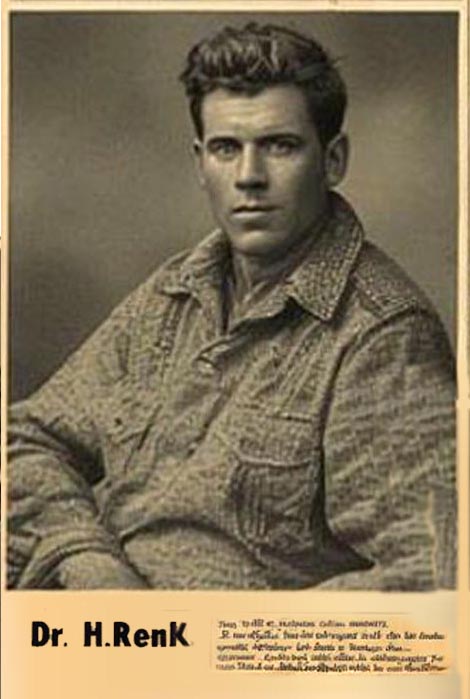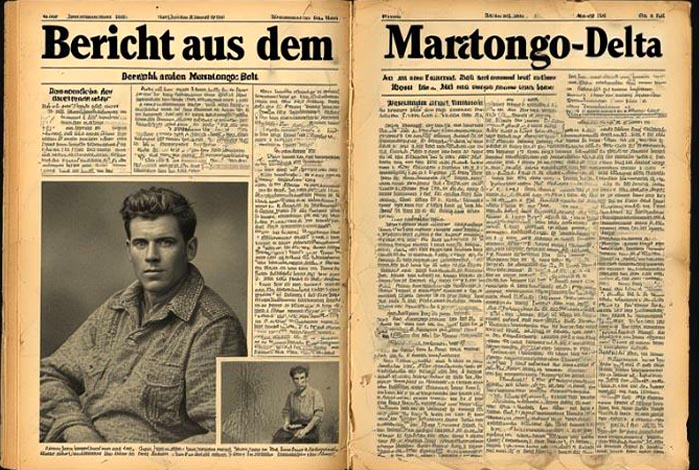Dr Heinrich Renk
Dr Heinrich Renk was a German ethnologist and cartographer who conducted field research in the Maratongo Delta in 1924. His work focused on mapping geocultural structures and documenting regions hitherto little explored during the colonial era. Renk is best known for his ethnographic report on the so-called Camp Maratongo, in which he examined the social organisation, the striking absence of cultural artefacts, and the dynamics of colonial control. In addition to his field reports, he maintained a lively correspondence with colleagues, most notably Elise Marquart, reflecting on the methodological challenges and ethical considerations of his work. Renk is regarded as an early practitioner of critically reflective colonial ethnography, whose sources remain fragmentary, speculative, and tantalisingly incomplete.
Into the Delta (1924–1926)
In 1924, Renk received funding from the Colonial Institute of Hamburg to conduct a comprehensive “geo-cultural survey” of the Maratongo Delta, a project whose stated aim was to document human–environment relations, though its unspoken purpose was to facilitate administrative control and resource mapping.
Armed with theodolite, notebooks, and an admirable degree of misplaced optimism, Renk and his small team established Camp Maratongo, a temporary research station perched on a shifting island of silt. Over two years, he produced meticulous hydrological records and hand-drawn maps of the Delta’s elusive river systems. His fascination with what he termed the “invisible pathways”—the temporary, reed-covered routes known only to local inhabitants—led him to an uncomfortable realisation:
“The map
deceives; it freezes movement. The
people, unbound by lines, live within
the current itself.”
It was an
unusually self-critical remark for a
colonial scientist in 1925.
Encounters and Misunderstandings
Renk’s principal interlocutor in the field was M’bala Thieno, a local cartographer and oral historian who introduced him to the Delta’s traditions of spatial storytelling. Their collaboration was fraught with both linguistic brilliance and mutual incomprehension. Renk described entire villages that “vanished overnight”—a phenomenon later understood as a form of deliberate withdrawal from colonial contact rather than the “nomadic instability” he initially recorded.
Modern historians now see in Renk’s observations an inadvertent documentation of resistance: his data were accurate enough, but his interpretations revealed the deep epistemic biases of the age.
The Maratongo Tables and Their Discontents
Upon returning to Germany in 1927, Renk published The Maratongo Tables—a compendium of maps, linguistic notes, and ethnographic sketches. The work was initially celebrated as a model of scientific precision; today it reads more like a mirror held up to the colonial gaze itself. His linguistic lists, compiled without consent and stripped of context, exemplify the period’s uneasy blend of curiosity and control.
By the 1930s, Renk’s correspondence with fellow ethnographer Elise Marquart reveals a growing unease with the moral implications of his discipline. In one of his later letters he wrote:
“We measure, we name—but we do not understand.
We chart the distance between ourselves
and those we call the observed.”
Disappearance and Legacy
After 1940, Renk’s traces fade from the historical record. Rumour has it he retired to the Bavarian Alps, where he worked on an unfinished manuscript titled Maps Without North—a meditation on knowledge, power, and the futility of cartographic certainty.
Today, Dr Heinrich Renk stands as an ambiguous figure: at once a product of colonial science and one of its earliest internal critics. His field notes from the Maratongo Delta survive only in fragments, but they continue to intrigue scholars interested in the entangled histories of exploration, ethics, and the many ways in which maps can both reveal and conceal.


